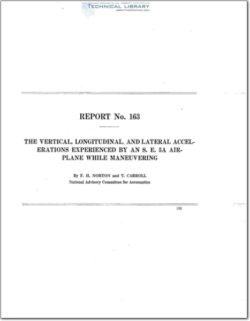naca-report-163

- Version
- 173 Downloads
- 283.88 KB File Size
- 1 File Count
- April 21, 2016 Create Date
- April 21, 2016 Last Updated
National Advisory Committee for Aeronautics, Report - The Vertical, Longitudinal, and Lateral Accelerations Experienced by an S. E. 5A Airplane While Maneuvering

This investigation was carried out by the Langley Field Laboratory of the National Ad-
visory Committee for Aeronautics for the purpose of‘measuring the accelerations along the
three principal axes of an airplane while it was maneuvering. The airplane selected for this
purpose was the fairly maneuverable S. E. 5 A. and the instruments used were the N. A. C. A.
three component accelerometer and the N. A. C. A. recording airspeed meter. The results
showed that the normal accelerations did not exceed 4.00 9. while the lateral and longitudinal
accelerations did not exceed 0.60 g.
The National Advisory Committee for Aeronautics has conducted in the past several in-
vestigations on the forces normal to the Wings experienced by an airplane in maneuvering. The
tests were made however on airplanes of the training type, so that it was felt desirable, now that
the committee had a combat airplane in good condition, to determine the loadings on this type
of airplane during maneuvers. It was also thought that a record of the accelerations along the
longitudinal and lateral axes would also be of interest because as far as it is known no such
records have previously been taken. The N. A. C. A. three component accelerometer which
has been recently developed allowed the recording of the three accelerations simultaneously.
The maneuvers carried out were the usual ones of a loop, roll, spin, a right and left Wing-
over turn, some side-slips and some skids. It should be kept in mind that the loads experienced
are by no means as great as could be obtained by very rough handling.
The airplane used in this investigation was a standard 8. E. 5A. with a Wright model E
engine, but with no military load (Fig. 1). The accelerometer was the N. A. C. A. three-com-
ponent instrument which has been previously described. This instrument was carefully
mounted on sponge rubber within a few inches of the center of gravity of the machine, in order
that it should not be afi'ected by angular accelerations. The recording airspeed meter was
connected to a swivelling pitot head on the wing strut and a calibration was made by flying
this airplane alongside of another airplane whose airspeed meter had been carefully calibrated.
Samples of the records obtained are shown in Figure 2.
| File | Action |
|---|---|
| naca-report-163 The Vertical, Longitudinal, and Lateral Accelerations Experienced by an S. E. 5A Airplane While Maneuvering.pdf | Download |

Comment On This Post